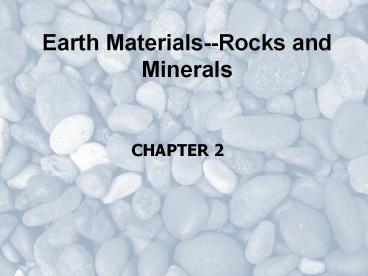Earth Materials--Rocks and Minerals - PowerPoint PPT Presentation
1 / 30
Title:
Earth Materials--Rocks and Minerals
Description:
Earth Materials--Rocks and Minerals CHAPTER 2 Minerals and Rocks Definition of a mineral: Naturally occurring Inorganic Solid Definite chemical composition (or range ... – PowerPoint PPT presentation
Number of Views:1489
Avg rating:3.0/5.0
Title: Earth Materials--Rocks and Minerals
1
Earth Materials--Rocks and Minerals
- CHAPTER 2
2
Minerals and Rocks
- Definition of a mineral
- Naturally occurring
- Inorganic
- Solid
- Definite chemical composition (or range)
- Orderly internal crystal structure
3
Mineral Importance
- Economic
- Conditions of environment
- Definition of a Rock
- An aggregate or one or more minerals
4
Physical Properties of Minerals
- Color - the color of the mineral as it appears to
the naked eye in reflected light. - Luster - the character of the light reflected
from the mineral. A mineral may have a metallic
luster or a non-metallic luster. - Hardness - the resistance of a mineral to
scratching. Hardness is measured on a scale of 1
- 10 called Mohs Hardness Scale. Hardness of
minerals can also be compared to common objects
(fingernail, copper penny, nail, glass).
5
Physical Properties of Minerals
- Cleavage - the tendency of a mineral to break
along flat surfaces related to planes of weakness
in its crystal structure. - Fracture - irregular breakage not related to
planes of weakness in the mineral. - Magnetism.
- Reaction to acid - The carbonate minerals react
with diluted hydrochloric acid (HCl) by
effervescing or fizzing, producing bubbles of
carbon dioxide gas.
6
(No Transcript)
7
Silicate Minerals
- Silicate Minerals have Si and O in their
formulas - Feldspars (60 of Earth's crust) plagioclase and
orthoclase varieties - Quartz
- Micas muscovite and biotite
- Hornblende (amphibole)
- Pyroxene (augite)
- Olivine
- Clay minerals
8
Minerals
- Nonsilicate minerals (8 of Earth's crust)
- Carbonates (with CO2) dolomite, calcite,
aragonite - Oxides (with O) hematite, goethite, limonite
- Halides (with Cl) halite, sylvite
- Sulfates (with SO4) gypsum, anhydrite
- Sulfides (with S) pyrite, galena
- Native elements gold, copper, silver
9
Figure 2-12 Geologic processes act continuously
on Earth to change one type of rock into another.
10
Igneous Rocks
- Igneous Rocks (90 by volume of Earth's crust)
- Cooling history of magma or lava is reflected in
the texture - intrusive (plutons, dikes, sills) phaneritic
(coarse) texture - extrusive (lava flows, ash falls) aphanitic
(fine) texture - two-stage (slow cooling followed by more rapid
cooling) porphyritic texture - Very rapid cooling may result in glassy texture
11
Igneous textures
12
Mineral composition, texture, and other
properties of common igneous rocks.
13
Igneous Rocks
- Crystallization of magma
- first-formed minerals have more perfect shapes
- Bowens reaction series helps us understand order
of mineral formation - continuous reaction series feldspar composition
changes - discontinuous reaction series iron-rich silicate
minerals reacts with liquid
14
A depiction of Bowens Reaction Series. Note that
the earliest minerals to crystallize are olivine
and calcium-rich plagioglase. As crystallization
proceeds, each mineral reacts with the melt to
form the mineral beneath it.
15
Volcanic Activity
- Volcanism (volcanic activity)
- Explosive- High Water, High Silica, High
Viscosity (example andesitic) - Quiet-Low viscosity, Low Silica, Low water
content (example basalt)
16
An andesitic melt resulting from fractional
crystallization of a basaltic magma.
17
Sedimentary Rocks
- Sediment loose particulate material (clay,
sand, gravel, etc.) - Derivation by weathering
- decomposition (chemical)
- disintegration (physical)
- Sediment becomes sedimentary rock through
lithification, which involves - Compaction
- Cementation
- Recrystallization (of carbonate sediment)
18
A conceptual diagram showing how the weathering
of granitic rock yields quartz grains for quartz
sandstone, clay for shale, and calcium for
limestone.
19
Types of Sedimentary Rocks
- Clastic (also called terrigenous or detrital)
- Conglomerate or Breccia
- Sandstone
- Siltstone
- Shale or Claystone
20
Clastic Sedimentary Rocks
Shale
Sandstone
Conglomerate
Breccia
21
Chemical/Biogenic Sedimentary Rocks
- Chemical/biochemical
- Evaporites
- Carbonate sedimentary rocks (limestones and
dolostone) - Siliceous sedimentary rocks
- Organic (coals)
22
Carbonate (calcite)
Halite
Coal
Chert
23
Metamorphic Rocks
- Metamorphic means "changed form"
- Agents of metamorphism
- Heat
- Pressure
- Chemically active fluids
24
Types of Metamorphism
- Contact metamorphism -alteration of rock by heat
adjacent to lava or magma - Regional metamorphism - alteration of rock over a
large area by heat and pressure due to deep
burial or tectonic pressure
25
Changes in minerals that will develop during the
progressive metamorphism of shale
26
Texture of Metamorphic Rocks
- Foliation - laminated structure in a metamorphic
rock resulting from the alignment of sheet-like
minerals (usually micas). - Non-foliated or granular metamorphic rocks are
those which are composed of equidimensional
grains such as quartz or calcite. There is no
preferred orientation. The grains form a mosaic.
27
Foliated Metamorphic Rocks
- The following are derived from the progressive
metamorphism of shale - Slate
- Phyllite
- Schist
- Gneiss (can also form from the metamorphism of
granite)
28
Foliated Metamorphic Rocks
Slate
Phyllite
Schist
Gneiss
29
Non-foliated Metamorphic Rocks
- Marble parent rock is limestone or dolomite
- Quartzite parent rock is sandstone
- Hornfels parent rock is shale or siltstone
- Greenstone parent rock is basalt
30
Non-foliated rocks
Marble
Quartzite































